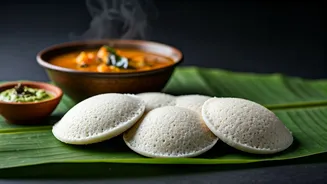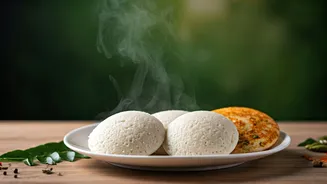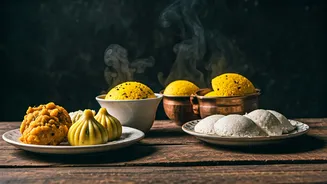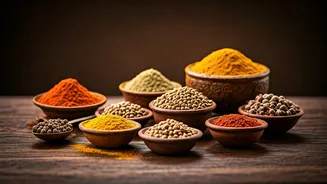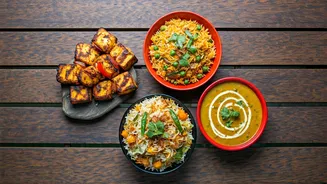Idli: The Classic
Idli, a South Indian staple, is a steamed rice cake that is incredibly light and easy to digest. It is made from fermented batter of rice and urad dal
(black lentils), a process that enhances its nutritional value and makes it a probiotic-rich food. The fermentation process increases the bioavailability of nutrients, making it easier for your body to absorb them. Idli is low in calories and fat, making it an excellent choice for those watching their weight. A plate of idli typically comes with sambar and chutney, adding further nutritional benefits from vegetables and spices. This combination provides a complete meal, offering carbohydrates, proteins, and essential vitamins and minerals. Preparing idli involves soaking the rice and lentils, grinding them into a smooth batter, allowing it to ferment overnight, and then steaming the batter in special molds. This process ensures the idli's soft and fluffy texture, making it a delightful breakfast option. This dish is suitable for all ages and dietary preferences, making it a versatile option in the Indian breakfast landscape.
Dhokla: Gujarati Delight
Dhokla, a beloved Gujarati snack, is a steamed cake made from fermented batter, often incorporating gram flour (besan). It is a savory, spongy treat that's not only delicious but also relatively low in calories. The fermentation process used in making dhokla introduces probiotics, enhancing gut health. The addition of spices such as ginger, green chilies, and mustard seeds boosts the flavour profile and provides antioxidant properties. Dhokla is usually steamed until it becomes light and airy, and then it's often tempered with a flavorful tadka of mustard seeds, curry leaves, and sometimes, green chilies. This process adds a crunchy texture and rich aroma to the dish. Dhokla is versatile and can be made in various ways, including khaman dhokla (made primarily from gram flour) and rava dhokla (made from semolina). It's typically served with chutney and is a fantastic breakfast or snack option. Dhokla's lightness and balanced flavours make it a popular choice across various age groups and dietary preferences.
Momos: Himalayan Treat
Momos, originating from the Himalayan region, are steamed dumplings that have gained immense popularity throughout India. They typically consist of a dough casing filled with a savoury mixture of vegetables, meat (usually chicken or pork), and spices. The traditional steaming method preserves the flavors and nutrients of the ingredients. The fillings are often seasoned with ginger, garlic, and various aromatic spices, giving the momos a distinct and delicious taste. Steaming is a healthier cooking method compared to frying, which reduces the amount of oil and fat content, making it a lighter breakfast option. Momos are often served with a spicy chutney or dipping sauce, which complements the flavors of the dumplings. They are a filling and satisfying breakfast choice, providing a good source of protein (from the fillings) and carbohydrates (from the dough). The variety of fillings allows for customization, catering to different dietary preferences. The steaming process ensures that all ingredients are cooked evenly, retaining their moisture and flavor, making momos a beloved breakfast option for many.
Modak: Sweet Steamed
Modak is a sweet dumpling particularly associated with the festival of Ganesh Chaturthi, though it can be enjoyed throughout the year. These dumplings are traditionally made from rice flour or wheat flour and are filled with a sweet mixture of grated coconut and jaggery. The entire dish is steamed, preserving its delicate flavor. Steaming keeps the modak light and helps in retaining the natural sweetness of the jaggery and coconut. The soft, chewy texture of the modak and the sweet, flavorful filling make it a delightful treat. It is a traditional and auspicious food, often offered to Lord Ganesha, and therefore, it holds a special place in Indian culture. Modak is not only delicious but also provides energy from the carbohydrates in the dough and the natural sugars in the filling. The grated coconut adds healthy fats and a unique texture. The preparation method requires careful shaping of the dumplings and precise steaming to ensure they are cooked perfectly. This makes modak a special and cherished breakfast or snack.
Puttu: Kerala Favorite
Puttu is a traditional breakfast dish from Kerala, made by steaming layers of rice flour and grated coconut in a cylindrical steamer. The combination creates a visually appealing and delicious breakfast. Rice flour forms the base, which is usually mixed with a little salt and sometimes spices. The rice flour is layered with grated coconut, providing texture and a subtle sweetness. The steaming process ensures that the puttu is fluffy and light. It is usually served with kadala curry (black chickpea curry) or a side of ripe bananas, providing a balanced and filling meal. Puttu is rich in carbohydrates from the rice flour and fiber from the coconut, making it a good source of energy. It is a simple yet satisfying meal, often enjoyed for breakfast in South India. The steaming method keeps the dish light and allows the flavors of the coconut and rice flour to blend perfectly. It's a quick and easy breakfast, perfect for busy mornings, while providing essential nutrients.
Idiyappam: String Hoppers
Idiyappam, also known as string hoppers, is a South Indian dish made from rice flour. The flour is pressed into thin, noodle-like strands and then steamed, creating a light and delicate texture. Idiyappam is a low-calorie option and can be a healthy addition to your breakfast. The process involves steaming the rice flour, often seasoned with salt and sometimes a touch of coconut milk, to form a dough. This dough is then pressed through a special tool to create the string-like strands, which are steamed until they become soft and fluffy. It is typically served with stew, vegetable kurma, or egg curry. The combination of the bland idiyappam with the flavorful side dishes makes for a delicious and well-rounded meal. Idiyappam is easy to digest and is often enjoyed by people of all ages. Its versatility and mild flavor make it a perfect breakfast option.
Thukpa: Tibetan Noodles
Thukpa, a Tibetan noodle soup, is a popular dish that has made its way into Indian breakfast menus. While variations exist, it typically involves steaming noodles in a flavorful broth that often includes vegetables and sometimes meat. The steaming process contributes to the overall lightness of the dish. The broth is usually rich with flavors derived from spices and vegetables, providing a warm and comforting start to the day. The inclusion of vegetables and protein, if meat is used, adds nutritional value. Thukpa is a hearty and filling option that is perfect for colder climates. Steaming the noodles in the broth allows them to absorb the flavors, creating a well-balanced and satisfying meal. The versatility of the dish allows for customization based on preferences, including the use of different vegetables, meats, and spices. It is a flavorful and nutritious option that can make breakfast interesting and enjoyable.





